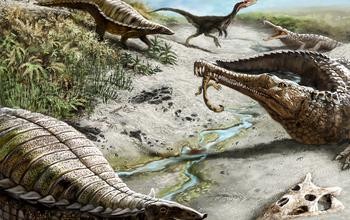Researchers have revealed that within the first 30 million years that dinosaurs came to existence, the dinosaurs preferred the temperate climate of farther north and south which led scientists to believe that the ancient creatures avoided the tropical regions like the plague.
According to an international group of scientists, this new study suggests that tropical climate during the age of dinosaurs was extremely hot and unpredictable. This hot and dry climate was also accompanied by unusual high levels of carbon dioxide.
This weather prevented large herbivore dinosaurs to inhabit the tropical regions for about 10 to 15 million years. Scientists also say that smaller flesh eating dinosaurs have moved to the tropical region some 200 million years back however, the giant plant eaters constantly stayed away from this region for a millenia.
Paleontologists say that this type of climate was so erratic that it changed drastically from wet periods to extremely dry periods of drought and heat where wildfires constantly ravaged the equatorial landscape. This in turn also affected the vegetation and plant biodiversity of the region that made it difficult for herbivores to thrive.
According to Randall Irmis from the University of Utah, this new data is suggesting that this was not a fun place to live. He says that larger, warm blooded herbivores were not able to dwell near the equator since plant food was not dependable.
Researchers also revealed that the tropical regions 200 million years ago is not similar to modern day tropics. According to lead author Jessica Whiteside from the University of Southampton, this extreme weather can be compared to the arid western region in the United States today where there were more trees and smaller plants near rivers and forests amidst humid conditions.
However, this constantly changing, harsh climate along with unpredictable wildfires would only indicate that smaller, two legged carnivorous dinosaurs will be able to survive.
In order to arrive at this conclusion, researchers analyzed rock samples from northern New Mexico from stream deposits and riverbeds some 205 to 215 million years ago. These samples revealed the ecosystem changes and carbon dioxide production in the atmosphere during that time.
This new study provides a glimpse of the past, million of years ago where carbon dioxide levels were four to six times higher than the current levels today however, this can also serve as a warning about the state of our environment today that might also provide a glimpse into the future of climate change.
This study is published in the Proceedings of the National Academy of Sciences.



























